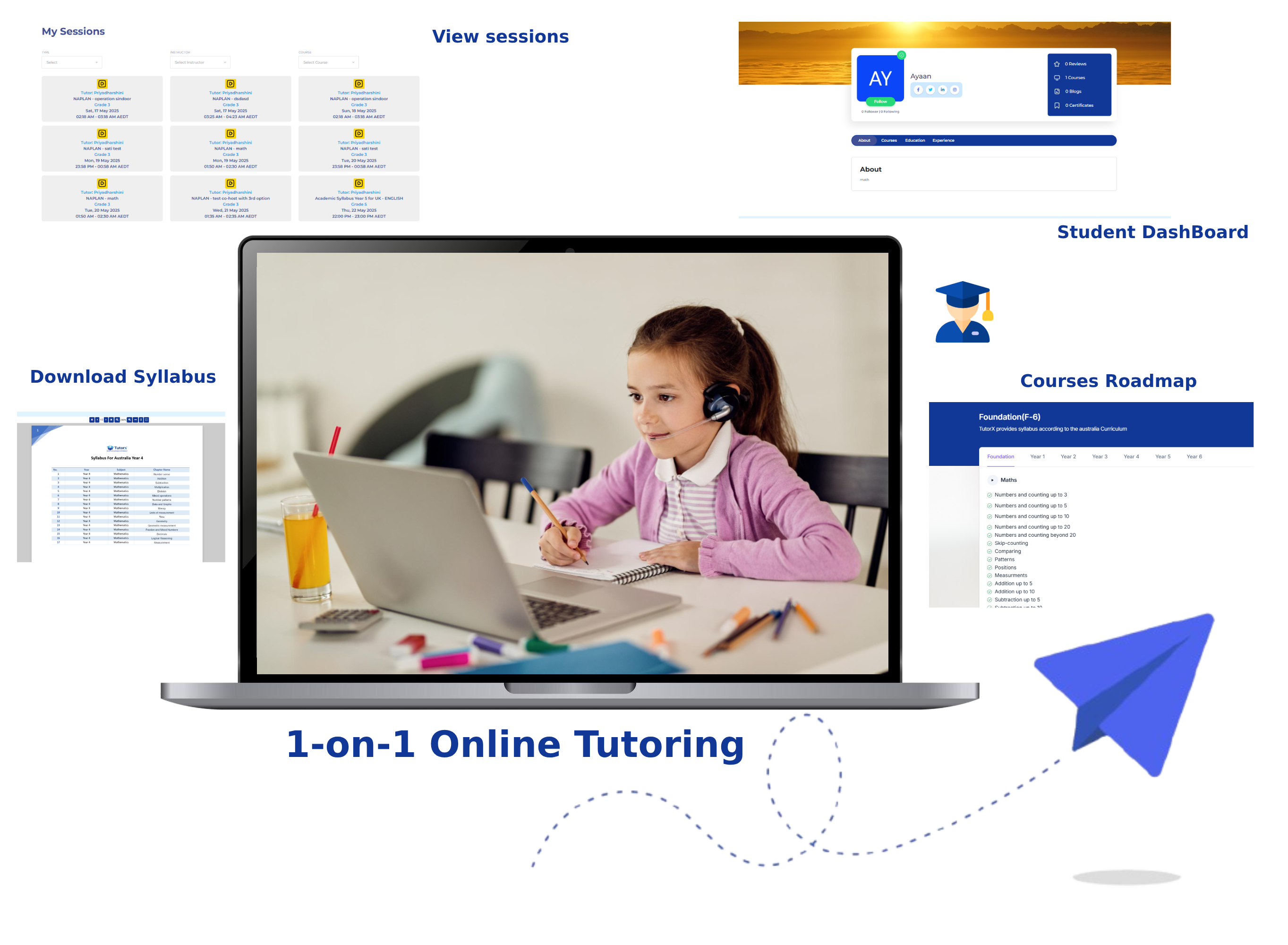Book a free trial session and start your personalized learning journey with our expert tutors.
Fill out the form below and one of our experts will contact you shortly.
Everything You Need, All in One Place
At The TutorX, we believe learning should be clear, focused, and at your fingertips. That’s why we’ve built a smart and user-friendly dashboard to empower every student on their academic journey. From live sessions and homework to performance tracking and resources—everything is seamlessly integrated to help you stay ahead with confidence.

The Australian Council for Educational Research administers the ACER Exam, a standardised examination designed to evaluate students’ academic performance. The examination is essential to scholarship programmes since it gives students a chance to demonstrate their competence and get financial support for their studies.

The ACER Scholarship Exam is designed to cater to students across a range of academic levels, typically from Year 4 to Year 12. To ensure that the evaluation is appropriate for the student’s knowledge and skills, each grade level has a unique test designed to fit the student’s academic stage.
Year 4 to Year 6: Foundational skills in writing, math, and general academic ability. Focus on identifying potential for early support and development.
Year 7 to Year 9: More challenging tests assessing critical thinking, problem-solving, and subject-specific knowledge in physics, math, and English.
Year 10 to Year 12: Assesses readiness for advanced academic work and potential success in demanding environments with a wide range of subjects.
| Level | Section | Format |
|---|---|---|
| Primary Level | Reading Comprehension | 30 multiple-choice questions |
| Mathematics | 30 multiple-choice questions | |
| Writing | One essay task | |
| Secondary Level | Reading Comprehension | 40 multiple-choice questions |
| Mathematics | 40 multiple-choice questions | |
| Writing | One extended essay task |
| Component | Description | No. of Questions | Time | Assessment Criteria |
|---|---|---|---|---|
| Reading and Viewing | Comprehension and interpretation of written and visual material. | 25 MCQs | 30 min | Comprehension & interpretation |
| Mathematics | Application of basic math skills: add, subtract, multiply, divide. | 20 MCQs | 30 min | Problem-solving & calculation |
| Writing | Two writing pieces in different genres. | — | 40 min | Ideas & structure of expression |
| Component | Description | No. of Questions | Time | Assessment Criteria |
|---|---|---|---|---|
| Humanities | Critical analysis of written and visual materials across disciplines. | 40–45 MCQs | 40 min | Critical thinking & judgment |
| Mathematics | Problem-solving: analysis, synthesis, relationships. | 32–36 MCQs | 40 min | Evaluation & critical reasoning |
| Science (Levels 2 & 3) | Scientific reasoning: logic, analysis, hypothesising. | Half of 32–36 | 40 min | Experiment & evidence analysis |
| Written Expression | 2 writing tasks based on a prompt (picture, statement). | — | 40 min | Thought, structure, expression |
The ACER Scholarship Level 1 Exam is designed to identify high-achieving students for academic scholarships. It consists of four distinct sections, testing a range of skills including writing, reading comprehension, and mathematical reasoning. The exam is known for its challenging problem-solving elements, even though the actual maths involved is often basic. Schools may customise the test, but the standard structure is as follows:
This section includes one writing prompt and must be completed in 25 minutes. The writing style can vary—students might be asked to write a narrative, persuasive, or discussion piece. To score well, students must focus on originality, staying on-topic, and structuring their work clearly. Grammar and vocabulary matter, but what really stands out are creative ideas and how effectively the student communicates them. It's essential to write according to the given prompt and avoid using memorised essays.
This is essentially a reading comprehension test with around 45 multiple-choice questions to be answered in 40 minutes. Students are presented with a variety of texts including fiction, non-fiction, poetry, diagrams, and maps. The subjects can range from English and History to Art and Social Studies. The key is to read carefully, understand the material, and answer based on the information provided, not prior knowledge. Success in this section depends on careful reading and logical thinking.
This section contains approximately 40 multiple-choice questions and lasts for 40 minutes. While the maths involved is usually basic (addition, subtraction, multiplication, and division), the real challenge lies in how the questions are framed. Students need to apply their knowledge in unfamiliar ways and solve real-world problems. This section often rewards logical reasoning and quick decision-making more than advanced calculations.
The final section is another writing prompt, again with a 25-minute time limit. The style of writing may differ from the first written task, which allows examiners to evaluate a broader range of writing abilities. Like the first writing task, this one values creativity, structure, and how well the response connects to the prompt. Proper grammar and spelling help, but they are not the primary focus—strong ideas and clear communication are what make an essay stand out.
Administrator

Lorem Ipsum is simply dummy text of the printing and typesetting industry. Lorem Ipsum has been the industry's standard dummy text ever since the 1500s, when an unknown printer took a galley of type and scrambled it to make a type specimen book.
Lorem Ipsum is simply dummy text of the printing and typesetting industry. Lorem Ipsum has been the industry's standard dummy text ever since the 1500s, when an unknown printer took a galley of type and scrambled it to make a type specimen book. It has survived not only five centuries, but also the leap into electronic typesetting, remaining essentially unchanged. It was popularised in the 1960s with the release of Letraset sheets containing Lorem Ipsum passages, and more recently with desktop publishing software like Aldus PageMaker including versions of Lorem Ipsum.
Reach out to TutorX your questions spark the path to smarter learning
